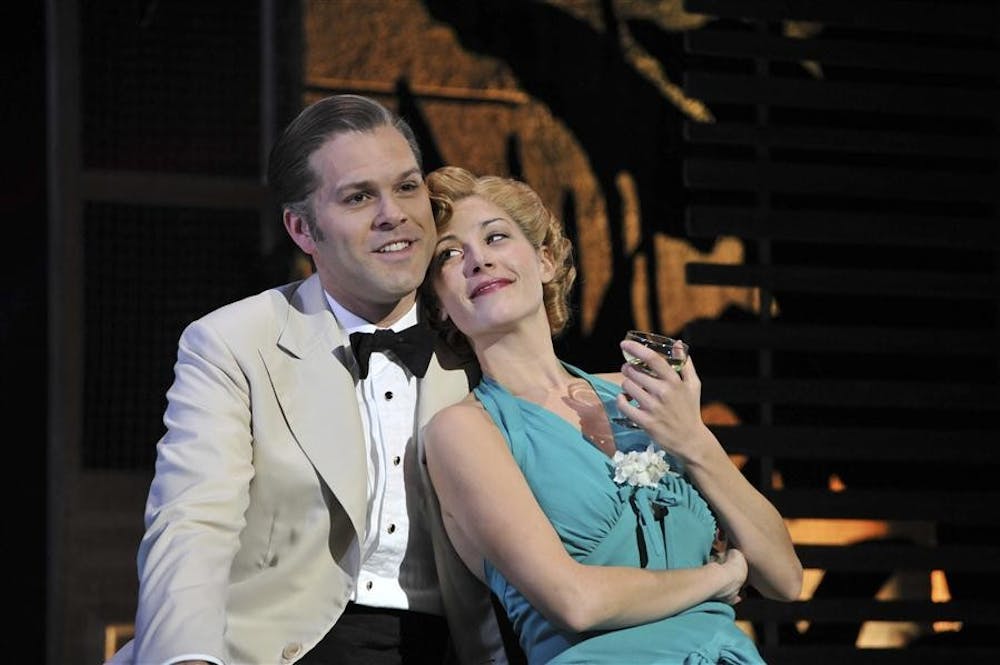An excerpt from the first page of James A. Michener’s “Tales of the South Pacific,” printed in a typewriter-style font, hangs on a screen downstage at the IU Auditorium.
“Whenever I start to talk about the South Pacific, people intervene,” Michener wrote. “I try to tell somebody what the steaming Hebrides were like, and the first thing you know, I’m telling about the old Tonkinese who used to sell human heads. As souvenirs!”
Music begins. Colorful stage lights reveal lush scenery. The curtain lifts for Tuesday night’s performance of “South Pacific,” Rodgers and Hammerstein’s musical adaptation of Michener’s book.
Company member Royce McIntosh, who plays radio operator Bob McCaffrey, said the show traveled for two days from Scranton, Pa., to perform two nights of shows in
Bloomington.
He said the company has performed across the country in venues ranging from community to professional theaters with a full orchestra.
“That change keeps it interesting,” McIntosh said. “You’re at a different demographic each time.”
Tuesday’s performance of “South Pacific” was both high spirited and emotionally heavy.
Ensign Nellie Forbush and Emile de Becque’s whirlwind romance offered several comical moments. Forbush, from Little Rock, Ark., asked de Becque, from France, if he knew what a hick was.
“A hick is one who lives in a stick,” de Beque answered.
The audience laughed.
“Sticks. Plural. The sticks,” Forbush corrected.
But while Forbush easily brushes away the fact that de Becque killed a man in France, she struggles to accept his two mixed-race children, Ngana and Jerome.
Bloody Mary, Michener’s “old Tonkinese woman,” barters with soldiers to buy her miscellaneous items. They teach her to heckle passersby in English, shouting “stingy bastard!” when a customer refuses to make a purchase.
“South Pacific” quietly reveals other racial tensions through the script and staging, including how the three black G.I.s always stand and interact separately from their white counterparts.
Perhaps most disturbing is the way Bloody Mary so eagerly pushes her teenage daughter, Liat, into the arms of Lt. Joseph Cable during his first visit to the island of Bali Ha’i. The two fall in love, but Cable refuses to marry Liat.
De Becque criticizes Cable, saying Cable’s racism is not inherent but learned.
Cable’s poignant song “You’ve Got to be Carefully Taught” was a turning point in the musical. He sang about the way parents teach their children to fear people who look different or have a different skin color.
In the final scene, Forbush fed de Becque’s children while he was away on a mission. She reprised the show’s first musical number, “Dites-Moi,” as he entered and realized her change of heart.
McIntosh said the company has done about 180 performances of “South Pacific” since the show opened in Boston in September, and it still has about 70 performances left before the tour ends in June.
“The hardest thing is keeping it fresh every time,” McIntosh said. “Even though we’ve done it so many times, it’s making it as if it’s the first performance.”
Sherry Risley traveled from Lafayette to Bloomington to visit her daughter Natasha, a junior at IU, and to see the show.
“It was very good,” Risley said. “I just really liked it all.”
McIntosh said he was happy with how Tuesday’s show went, considering the long bus ride and hectic performance schedule.
“All of us are very excited to be part of this,” McIntosh said.
'South Pacific' explores notions of love, racism

Get stories like this in your inbox
Subscribe





